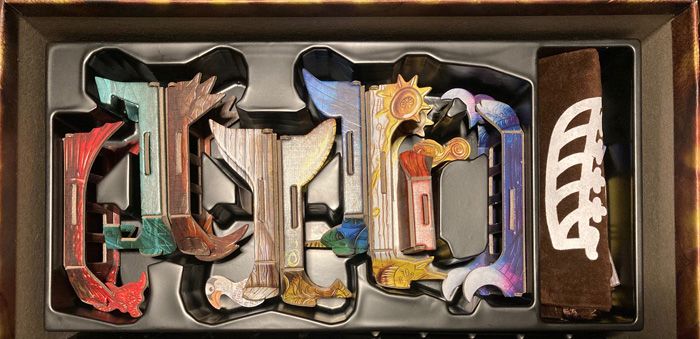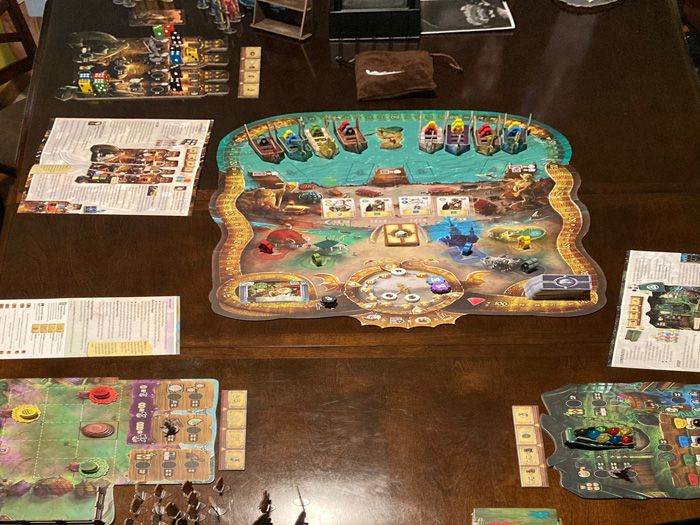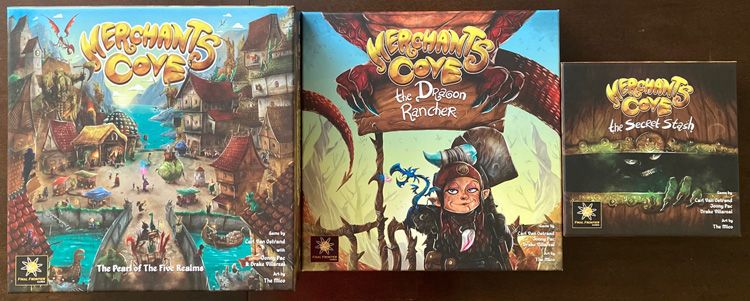Merchants Cove: The Pearl of the 5 Realms is a game published by Final Frontier Games. The premise of the game is for players to take on the role of merchants, each producing and selling unique goods to the incoming adventurers. The game spans three rounds, or days, after which the merchant with the most gold is declared the winner.
This post is broken into the following 3 sections, feel free to jump directly to one:
- General summary - consisting of information about overall enjoyment, theme, replayability, and upgrades
- Complexity - consisting of information about the rulebook, setup, player turns, and overall learning curve
- Player turns - consisting of game type, game flow, rule you are likely to miss, and favorite aspect
General Summary
Number of players we had: 3
Our play time (not including setup): 2 hours 25 minutes
Overall enjoyment

Our group enjoyed this game for several reasons. We appreciated how you can play the game using a higher level of strategy without it having heavy mechanics or taking 4+ hours. Standard, Merchants Cove comes with multiple merchant roles, rogue cards and types of townsfolk that modify the game. There are several expansions that can change things up and increase the complexity. Parts of this game also involve a little bit of luck, which caused us to pay close attention.
Players have customized role-specific boards, tokens and actions which is very unique. Turn order is also very different and cause a player to end up with multiple turns in a row. Adventurers are added to boats as players take actions and move around the clock, so while players are planning their next actions, they still need to pay attention because the best strategy might be different after another player takes their turn.
If we had to pick something that frustrated us it would be that we do not understand the symbols on some of the rogue cards. I mixed the original and expansion rogue cards, which is quite possibly what caused this problem. I suspect if I spend a few minutes online, I will be able to find the answers I am looking for and this did not detract from our game enjoyment at all.
Theme

The components are very detailed and match the theme of the main board very well. There unique merchant game boards are also extremely detailed and well made. Each player board comes with matching components only for that player which takes the theme up another level. Scoring is tracked by following a dragon that wraps around the outside of the board which keeps it out of the way, and also makes it easy to use.
We also love the 3D boats, and though they take some time to assemble and you must be careful, they are worth the effort. We also appreciate the specially molded trays that hold these post-assembly to protect them for the long haul!

Replayability

Since merchants each play their own game to produce supplies, this game could continue to add expansions with new merchants, and players would be hard pressed to get bored. While we played we really had no idea how each other's side games worked, which will make them that much more fun whenever we play them.
Additionally, there are multiple types of townsfolk, each with different effects on the game, and several rogue cards that also modify game play which keeps the game interesting.
Upgrades

I purchased the Secret Stash and the Dragon Rancher (which I thought was a super fun merchant to play) when I originally backed this game on Kickstarter. I have also read about other expansions I intend to check out. Even with the expansions I already have, there are over a dozen rogue cards that can change up the game, additional types of townsfolk and additional merchants. We love the additional boats, cards, merchants and tokens in the expansions.
Complexity
Rulebook
The main rulebook has large images and examples of game play and is fairly easy to follow and understand. The board setup and pieces are well imaged and numbered. Setting up the main board can be accomplished in about 10 minutes.
The smaller role-based books are also easy to understand and both book types have a summary on the back page for easy reference which comes in handy! While the role-based merchant books are small and provide explanations, it can take a little time to fully understand how your character operates.
It is important to stress that each player has their own set of rules for producing supplies. This means those players who often ask more questions or take longer to pick up the flow of a game might be slightly intimidated by this game. This game does have some complexity, but it appears FAR more complex than it really is once you begin playing.
Setup
Setting up the main board is fairly quick and straightforward. Where it gets more complex is with each merchant and their role-specific boards, tokens and rules. We set up the main board then chose our merchants and spent the next 15-20 minutes familiarizing ourselves with how our particular merchant worked. This gave us enough time to create a strategy and once we began playing we didn't have to stop a bunch of times to figure things out.
Turns
Every action in the game costs time and possibly corruption cards. Time for each merchant is tracked by a clock on the main board. Each time a player takes an action, their time piece is moved around the clock according to the time cost of that specific action, typically one or two hours.
The merchant time pieces also determine player order. Whichever merchant is furthest behind, or furthest behind and stacked on top of another player, is next to take a turn. This makes player turns somewhat unpredictable and ensures you are paying attention and strategizing most of the time.
Merchants do have some common actions such as recruiting townsfolk and activating staff. Most other actions are specific to the role of the merchant and their time costs vary. Also, no merchant can perform the same action twice in a row, so you must plan your actions wisely to ensure you produce goods before the clock runs out on a round or you might not have the right items to sell to the adventurers.
Overall learning curve
This game feels far more overwhelming when you first set it up than it really is. We have played it twice so far and both times we briefly got overwhelmed, only to transition into two really fun, high-scoring games that we finished wanting to play again. I encourage anyone who is not sure if they are up for this game to at least give it a try.
When broken down, the play is not overly complex, and you can play several phases together. If you wanted, you could also learn the different merchant moves together to help fellow players, but I suspect most players will not find this necessary. Also, once you have played a specific merchant, you can easily offer assistance to a new player who is learning how to play that merchant.
Player Turns
Play type
This game is slightly worker placement and is symmetrical at times while asymmetrical at others. There is plenty of strategy, some luck with filling boats and producing the right types of supplies at the right time, and while more complex than some games, not overly complicated or extremely challenging to learn.
Game flow
Since every merchant has their own player board, very few actions can conflict with other players. As a result, once players complete an action, they can focus on their next move while other players resolve their actions.
The one way players can interfere with other players strategy is which boat they choose to add new adventurers to and also where they dock fully-loaded boats. In other words, every time a player adds an adventurer, they are going to put them in boats with adventurers that match the colors of the supplies they have produced as this will gain them more gold. This may or may not coincide with what you have produced, so pay close attention to what color supplies other players have produced as well as the boats as they are being filled.
Overall, game flow is fluid and since player turns are not predictable and boats can be filled and docked at any time, players pay attention. Lastly, because the game is limited to three days/rounds, and each merchant is limited to a certain number of actions based on the clock, the game moves quickly.

Rule you are likely to forget
There are two rules you might forget when playing this game. They are:
- When both docks on either side of the cove have boats, the adventurers sailing in the remaining boats on that side are removed and placed in their respective faction halls or the lair, NOT placed back in the adventurer bag.
- When each dock space is filled with a boat, the market space indicator moves to the first hour available after the furthest forward player piece on the clock.
Favorite aspect
This game has a lot going on without being complex just for the sake of being complex. I love that players need to pay attention because turns are not as predictable as some games. Also, each player affects how boats are filled and when they are docked, even though there is really no guarantee the boat you want to arrive at a dock will be the one chosen.
One other thing I love is how perfect the plastic inserts are for the game pieces. There are specific inserts for each merchant's tokens and display. Additionally, there are diagram sheets for each tray that show how they are supposed to be filled, including the boats, which makes it very easy to set up and store this game.
In summary, we really like the theme of this game and the attention to detail that was paid by the developers. There are all kinds of expansions we have yet to even touch, but are excited to try out. Also, while it may look intimidating at first, this game is really fun and not overly complex. Once setup, this game can be played in less than 3 hours (with 3 players) without players feeling rushed.


